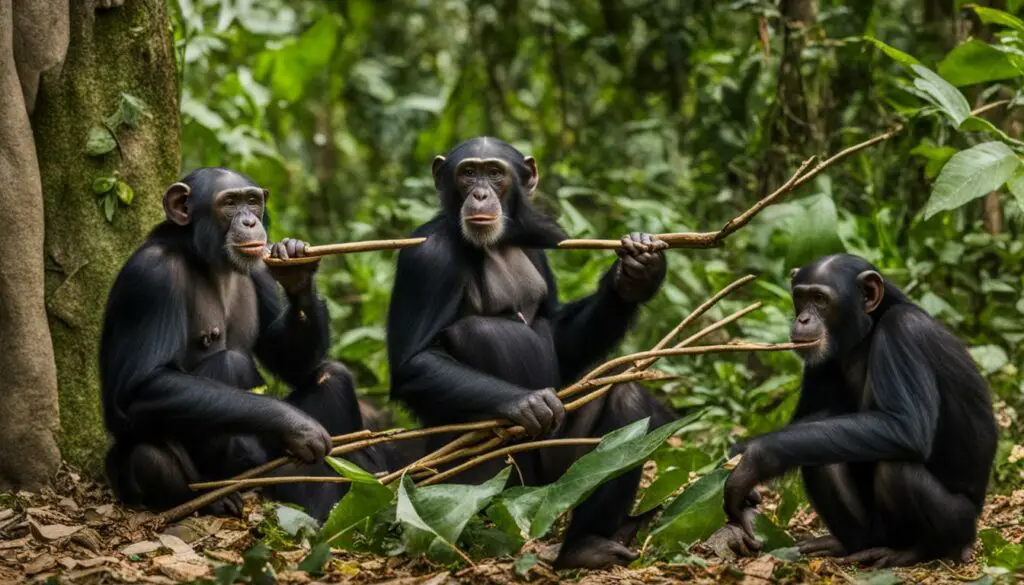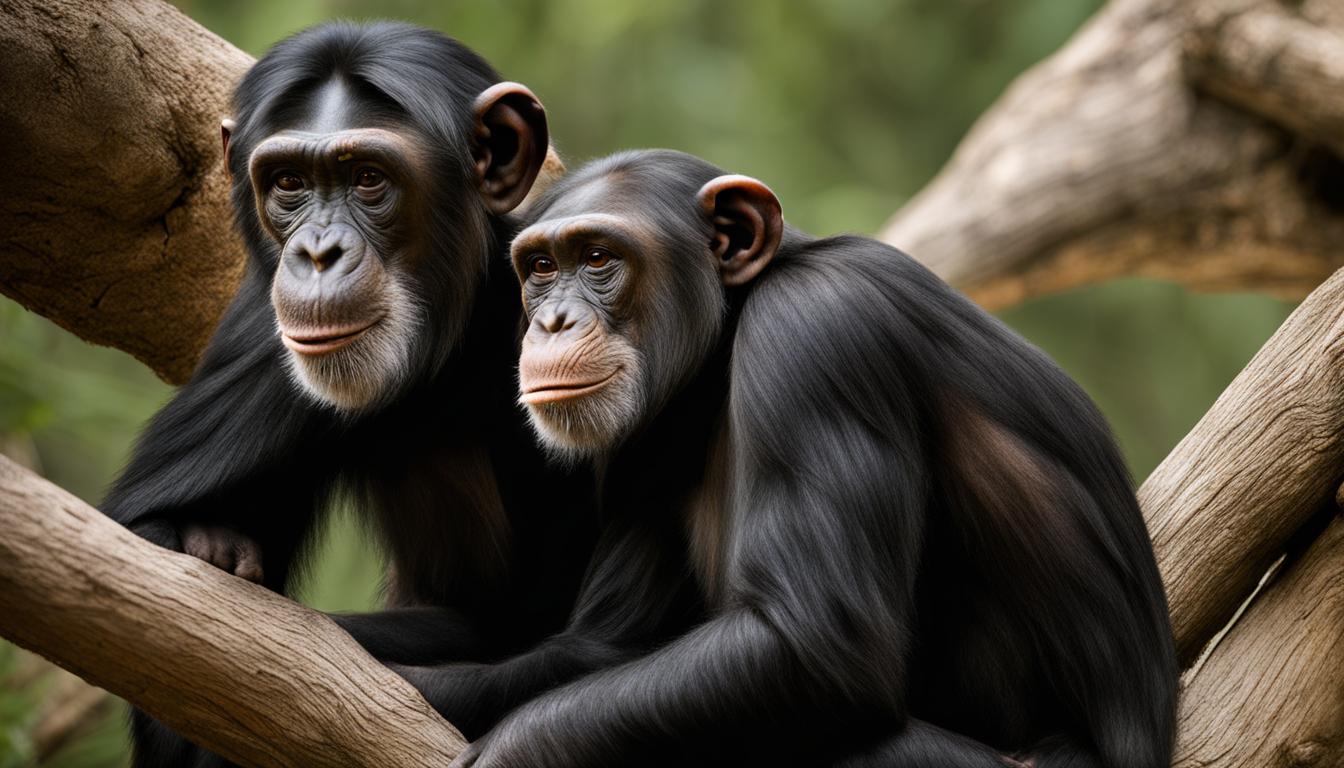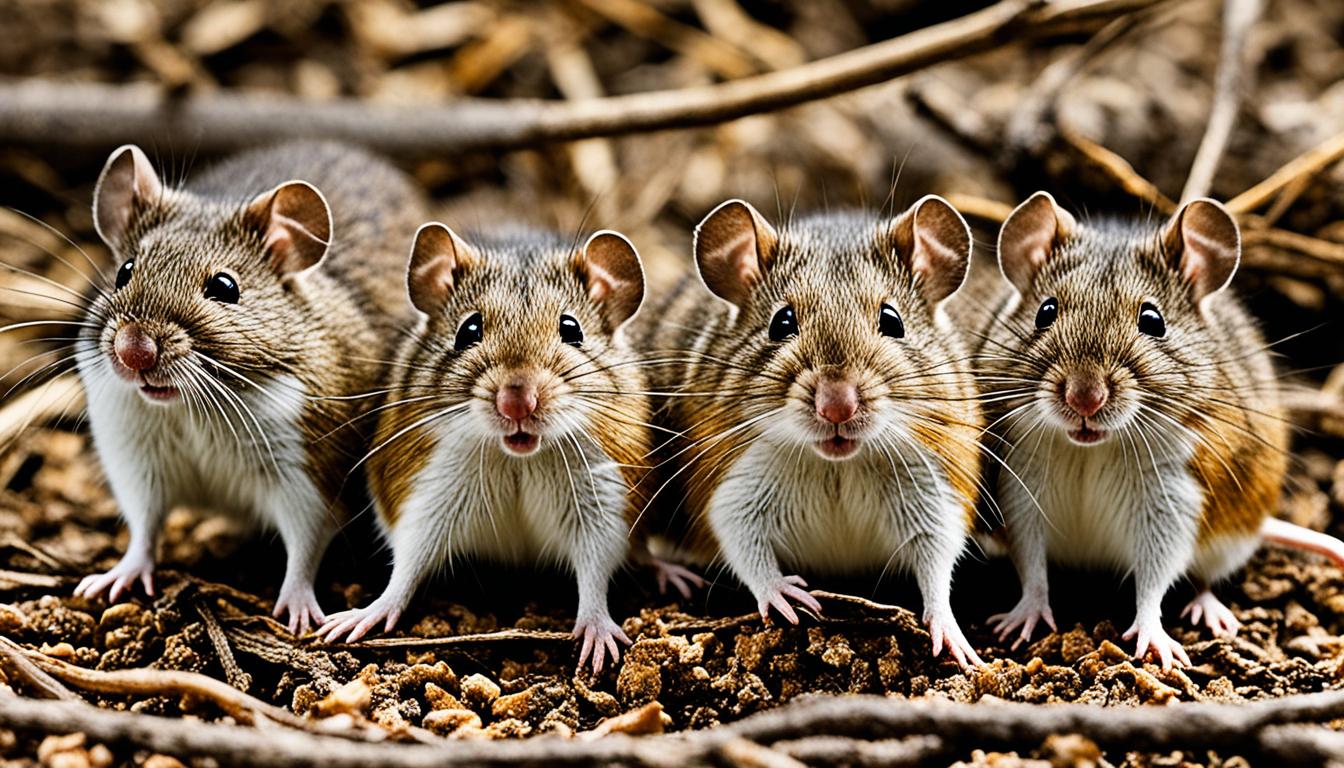Chimpanzees are fascinating creatures with distinctive physical features that set them apart from other primates. Their unique characteristics and traits make them a subject of great interest and study. In this section, we will explore the physical attributes that make chimpanzees so remarkable.
Chimpanzees have a coat of coarse black hair that covers their entire body, giving them a distinctive appearance. Their face, fingers, toes, palms of the hands, and soles of the feet are bare, which allows for better dexterity and grip. This adaptation makes them skilled climbers and enables them to manipulate objects with precision.
Furthermore, chimpanzees are larger and more robust than their close relatives, bonobos. Adult males can weigh between 40 and 70 kg and stand at an average height of 150 cm. These physical characteristics contribute to their strength and agility, allowing them to navigate their varied habitats with ease.
By understanding the unique physical features of chimpanzees, we can gain a deeper appreciation for these incredible creatures and the adaptations that have helped them thrive in their environments.
Habitat and Range of Chimpanzees
Chimpanzees are highly adaptable primates that can be found in various habitats across Africa. They are known to inhabit diverse ecosystems, including savanna woodlands, grassland-forest mosaics, and tropical moist forests. Their ability to thrive in different environments is a testament to their versatile nature and resourcefulness.
The range of chimpanzees spans across multiple countries in Africa, covering a wide geographical area. These countries include Angola, Burundi, Cameroon, Central African Republic, Republic of Congo, Democratic Republic of the Congo, Côte d’Ivoire, Equatorial Guinea, Gabon, Ghana, Guinea, Guinea-Bissau, Liberia, Mali, Nigeria, Rwanda, Senegal, Sierra Leone, Sudan, Tanzania, and Uganda. Chimpanzees are part of the Afrotropical biogeographic realm, and their presence in these countries contributes to the rich biodiversity of the region.
Chimpanzees can be found at varying elevations, ranging from sea level to about 3,000 meters. This wide altitudinal range showcases their ability to adapt to different climatic conditions and ecological zones within their habitats. The diverse habitats and extensive range of chimpanzees highlight their resilience and their capacity to survive and thrive in various settings.
| Chimpanzee Habitat | Chimpanzee Range |
|---|---|
| Savanna Woodlands | Angola, Cameroon, Central African Republic, Republic of Congo, Democratic Republic of the Congo, Sudan |
| Grassland-Forest Mosaics | Guinea, Guinea-Bissau, Liberia, Mali, Senegal, Sierra Leone |
| Tropical Moist Forests | Burundi, Côte d’Ivoire, Equatorial Guinea, Gabon, Ghana, Nigeria, Rwanda, Tanzania, Uganda |
Chimpanzee Anatomy and Body Structure
The anatomy and body structure of chimpanzees are well-adapted to their habitats and way of life. They have a coat of coarse black hair that provides protection and camouflage in their forested environments. Their bare face, fingers, toes, palms of the hands, and soles of the feet help with gripping and grasping objects, enabling them to climb trees and manipulate tools with ease.
Chimpanzees are larger and more robust than their close relatives, bonobos. Adult male chimpanzees can weigh between 40 and 70 kilograms and stand at an average height of 150 centimeters. Their muscular build and physical strength are advantageous for various activities, including foraging, hunting, and defending their territories.
The unique physical features of chimpanzees, combined with their adaptability to different habitats, make them highly successful primates in the African continent. Their ability to navigate diverse landscapes and utilize their anatomy and body structure effectively contributes to their survival and ecological significance.
Social Behavior and Life Cycle
Chimpanzees are highly social animals with a complex social structure. Their communities consist of loose and flexible groups led by a dominant male. The size of the communities can range from about 15 to 80 individuals, with subgroups that constantly change in composition.
Chimpanzees breed throughout the year and females give birth to a single young, occasionally twins. The gestation period is between 202 and 261 days. The young cling to their mother for the first 6 months and then ride on their mother’s back. They are weaned at 3.5-4.5 years but remain reliant on their mother for a longer period. Chimpanzees reach sexual maturity at around 7 years, but females do not produce offspring until they are 13-14 years old. Chimpanzees have a relatively long lifespan and can live until they are over 60 years old.
Understanding the social behavior and life cycle of chimpanzees is crucial in appreciating their unique characteristics and conservation needs. These animals form complex social structures and exhibit nurturing behaviors towards their young. The close bond between mother and offspring highlights the importance of maternal care in chimpanzee society. Additionally, the relatively long lifespan of chimpanzees emphasizes the need to protect their habitats and ensure their survival for future generations.
Diet and Feeding Habits of Chimpanzees
Chimpanzees have a diverse and adaptable diet, making them omnivorous creatures. They consume a variety of foods including fruits, leaves, honey, insects, eggs, and occasionally meat. Chimpanzee diet is primarily herbivorous, consisting of fruits and leaves, which make up a significant portion of their food intake. They are known to spend a considerable amount of time foraging, dedicating 6-8 hours a day to search for food. Their feeding habits may vary depending on the availability of different food sources in their habitats.
One of the remarkable characteristics of chimpanzees is their ability to use tools for feeding. They have been observed using sticks and twigs to extract insects from nests, and they even use stones to crack open nuts. This behavior showcases their intelligence and problem-solving abilities.
Furthermore, chimpanzees have been known to engage in cooperative hunting, where they work together to stalk, kill, and consume other primates or young antelopes. This behavior demonstrates their advanced social interactions and strategic hunting techniques.
| Food | Percentage of Diet |
|---|---|
| Fruits | 50% |
| Leaves | 30% |
| Insects | 10% |
| Honey, Eggs, and Meat | 10% |
Chimpanzees’ dietary preferences may vary depending on the season and availability of certain foods. For example, during fruiting seasons, their diet may be predominantly fruit-based, while in times of scarcity, they rely more on leaves and other available food sources. This ability to adapt their feeding habits to changing conditions reflects their resourcefulness and survival instincts in the wild.
Conservation Status and Threats to Chimpanzees
Chimpanzees are an endangered species, facing numerous threats that have significantly reduced their population in the wild. The International Union for Conservation of Nature (IUCN) estimates that there are between 170,000 and 300,000 individuals across their range. The conservation status of chimpanzees highlights the urgent need for action to protect these incredible animals and their habitats.
The biggest threats to chimpanzees include habitat loss, poaching, and disease. Human activities such as logging, farming, and mining result in the destruction and fragmentation of their habitats. This loss of suitable habitat makes it difficult for chimpanzee populations to thrive and expand. Additionally, chimpanzees are often targeted by poachers for bushmeat, traditional medicine, and the illegal pet trade. These illegal activities further contribute to the decline of their populations.
“The biggest threats to chimpanzees are habitat loss, poaching, and disease.”
Diseases, particularly those transmitted from humans, pose a significant risk to chimpanzees. The close genetic relationship between humans and chimpanzees makes them susceptible to infectious diseases such as respiratory infections, Ebola, and other zoonotic diseases. Outbreaks of diseases can spread rapidly among chimpanzee populations, causing high mortality rates and further endangering their survival.
Conservation efforts are ongoing to protect and preserve chimpanzees and their habitats. These efforts involve establishing protected areas, enforcing anti-poaching measures, promoting sustainable land use practices, and raising public awareness about the importance of chimpanzee conservation. Collaborative initiatives between local communities, governments, non-profit organizations, and researchers are key in ensuring the long-term survival of chimpanzees in their natural habitats.
| Threats to Chimpanzees | Conservation Measures |
|---|---|
| Habitat loss from logging, farming, and mining | Establishment of protected areas and corridors, sustainable land use practices |
| Poaching for bushmeat, traditional medicine, and the pet trade | Anti-poaching measures, law enforcement, community education and alternative livelihoods |
| Disease transmission, including zoonotic diseases | Monitoring and surveillance, disease prevention and control measures, veterinary care |
Unique Behaviors and Adaptations of Chimpanzees
Chimpanzees, our closest living relatives, exhibit a fascinating array of unique behaviors and adaptations that highlight their intelligence and resourcefulness. One of their most famous behaviors is tool use, where they modify sticks, rocks, grass, and leaves to aid in hunting and acquiring food. In fact, chimpanzees have been observed creating sharpened sticks to spear small mammals, showcasing their ingenuity in problem-solving and acquiring sustenance.
Moreover, chimpanzees display remarkable social strategies that involve cooperation, coalition-building, and resource sharing. They engage in combat with rival groups, cultivate alliances to enhance their chances of success, and demonstrate a level of complexity in their social interactions rarely seen in other animals. This cooperative nature, combined with their strong familial bonds, allows chimpanzees to navigate the complex dynamics of their social groups.
Chimpanzees also exhibit emotional and cognitive abilities that parallel humans. They have displayed self-recognition, curiosity, sympathy, grief, and even deception. Their ability to understand others’ perspectives and engage in sophisticated social behaviors further highlights their complex and unique nature.
Chimpanzees’ adaptations extend beyond their behaviors. They have physical features perfectly suited to their habitat and lifestyle. Their strong, flexible fingers and opposable thumbs allow them to grasp and manipulate objects with precision, making tool use and foraging easier. Additionally, their highly dexterous hands and inquisitive nature enable them to explore their surroundings and solve problems.

Table: Comparison of Chimpanzee Behaviors and Adaptations
| Behavior/Adaptation | Description |
|---|---|
| Tool Use | Chimpanzees modify objects to aid in hunting and acquiring food, showcasing their problem-solving abilities. |
| Cooperative Strategies | Chimpanzees engage in combat, cultivate alliances, and share resources, demonstrating their complex social dynamics. |
| Emotional Intelligence | Chimpanzees exhibit a range of emotions, including self-recognition, curiosity, sympathy, grief, and deception. |
| Physical Adaptations | Chimpanzees have strong, flexible fingers, opposable thumbs, and dexterous hands, enabling them to manipulate objects and explore their environment. |
These unique behaviors and adaptations contribute to the incredible adaptability and survival of chimpanzees in their habitats. As we continue to study and understand these remarkable creatures, we gain a greater appreciation for their complex social structures, cognitive abilities, and resourceful nature.
Conclusion
Chimpanzees are truly remarkable creatures with unique physical characteristics and intriguing behaviors. Their coat of coarse black hair, bare face, fingers, toes, palms of the hands, and soles of the feet set them apart. Their larger and more robust body structure distinguishes them from their bonobo counterparts. Chimpanzees are highly adaptable, inhabiting various habitats ranging from savanna woodlands to tropical moist forests.
These social animals have a complex social structure, living in loose and flexible groups led by a dominant male. Their breeding habits and life cycle exhibit fascinating patterns, with females giving birth to a single young and the young relying on their mothers for an extended period. The diverse diet and feeding habits of chimpanzees, including the use of tools for foraging, highlight their intelligence and resourcefulness.
Unfortunately, chimpanzee populations are facing significant threats. Their habitat loss, hunting, and disease outbreaks have caused their numbers to dwindle. It is crucial that we actively work towards conserving and protecting chimpanzees to ensure their survival. By understanding their physical characteristics and behaviors, we can better appreciate the importance of safeguarding these incredible animals for future generations.
Can you provide more details about the unique physical features of chimpanzees?
Chimpanzees possess a variety of unique physical features. They have elongated arms, allowing them to swing effortlessly through the trees. Their opposable thumbs enable precise gripping and tool use. Additionally, chimpanzees exhibit remarkable strength, thanks to their robust muscular build. Their facial expressions and body language play a crucial role in communication within their social groups. Overall, these distinctive traits make chimpanzees fascinating creatures to study.
FAQ
What are the unique physical features of chimpanzees?
Chimpanzees have a coat of coarse black hair, a bare face, fingers, toes, palms of the hands, and soles of the feet. They are larger and more robust than bonobos, with adult males weighing between 40 and 70 kg and standing an average height of 150 cm.
Where are chimpanzees found?
Chimpanzees are found in various habitats including savanna woodlands, grassland-forest mosaics, and tropical moist forests. They can be found from sea level to about 3,000m in elevation. Their range spans across multiple countries in Africa, including Angola, Burundi, Cameroon, Central African Republic, Republic of Congo, Democratic Republic of the Congo, Côte d’Ivoire, Equatorial Guinea, Gabon, Ghana, Guinea, Guinea-Bissau, Liberia, Mali, Nigeria, Rwanda, Senegal, Sierra Leone, Sudan, Tanzania, and Uganda.
How do chimpanzees live in groups?
Chimpanzees have a complex social structure with loose and flexible groups led by a dominant male. The size of the communities can range from about 15 to 80 individuals, with subgroups that constantly change in composition.
What do chimpanzees eat?
Chimpanzees have a diverse diet that includes fruits, leaves, honey, insects (especially termites), eggs, and occasionally meat. They eat with their hands and use tools such as sticks to forage for insects and crack nuts.
What is the conservation status of chimpanzees?
Chimpanzees are an endangered species. Their population in the wild has been significantly reduced due to hunting, habitat loss from logging and farming, and commercial exportation for zoos and research laboratories.
What unique behaviors do chimpanzees exhibit?
Chimpanzees are known to use tools, modify sticks, rocks, grass, and leaves to aid in hunting and acquiring food. They can create sharpened sticks to spear small mammals and have been observed using certain plants medicinally. Chimpanzees also exhibit complex social strategies such as cooperation in combat, the cultivation of coalitions and alliances, and the sharing of resources.
What should we conclude about chimpanzees?
Chimpanzees are fascinating creatures with unique physical features and complex social behaviors. They have a diverse diet and exhibit various adaptations and behaviors to survive in their habitats. However, their populations are threatened by habitat loss, hunting, and disease. Efforts to conserve and protect chimpanzees are crucial in ensuring their survival.











